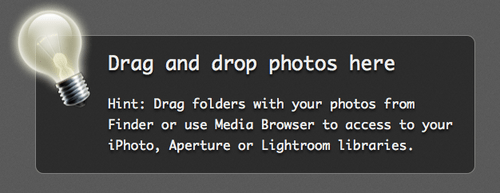Photosweeper (OS X) Review

Photosweeper Review
At this point in time, photo management is the new norm. Quite simply, we take too many photos to keep track of them manually. The tools we have are pretty good, allowing for quick edits, be it color correction, cropping or other (usually) non-destructive edits. Despite the plethora of options„ there’s quite a vacancy in this space: Whatever your poison is, Lightroom, Aperture or even iPhoto, none of these do much in the way of duplicate detection (outside of exact duplicates).
To the rescue!

Photosweeper’s aim is to find and destroy duplicates of photos. Its a one trick pony but it performs this trick exceptionally well. Rather than simply find exact matches, it instead creates thumbnail images for analysis and then identifies near-matches. It doesn’t matter if they’re different formats (JPG vs PNG vs RAW vs PSD), different resolutions, or even separate photos altogether that are remarkably similar. It also doesn’t matter if you use iPhoto, Lightroom or Aperture or any combination of the three, Photosweeper is capable of finding any and every photo.
For my test, I used my own Photo library, largely in Lightroom 5 and some free floating files. To add to the mix, I have an out-of-date version of Aperture and iPhoto, each with their own respective databases from years ago. Like many , my library spans many years and many cameras. I had photos ranging from a Powershot A70, Canon 300d, iPhone 3G, 4 and 5, Panasonic GM-6 and some captures from a previous employer’s 7D.
My pictures folder totaled 129 GBs. Anything shot it the past three years has been managed by Lightroom, before that…. well, most of my “organization” I handled by drag and drop.
I’ve debated cleaning my Photo library prior but the task never quite made it on my “to-do” list, perpetually on my “Clean one day”.
Init Run

On my first run (in typical user-interface developer fashion) I skipped most of the tutorial screens, eager to see what I could do. It took a moment of confusion as I assumed that I had to import each library one-by-one. I noticed the rather large text suggesting I drag and drop my photos into Photosweeper. I added my Pictures folder and set the scan size to the maximum resolution (128 x 128).
With years and years of photos (23,000 to be exact), I worried that this process may range into the days. It took roughly 2 hours for it to munch through all the photos on my 2008 Mac Pro (2x 4-core 2.8 GHz, 14 GB of Ram) off my 2 TB HDD.
The results appear in real time, you don’t have to sit and wait for the process to finish, you can start identifying duplicates in soon the query makes its first discovery. Photosweeper also works on videos, a nice bonus and worth a mention.
Elegenance
When attempting to identify duplicates, Photosweeper lets you set the tolerance level. I went fairly strict, as I wanted to cut out only exact duplicates, and rid myself of lower resolution/lower quality exports. With the tolerance ramped to maximum, only near identicals appeared as duplicates.
Without much thinking, I adjusted the preview window sizes to maximum and started manually removing duplicates. As far as user-interfaces go, Photosweeper gets an A. Its familiar, in a good way. It only took seconds to figure out user interactions. Anyone used to using a photo manager can dive in without much trouble.

Photosweeper offers a suite of logic markers to identify which photos to keep. I tested out the auto duplicate detection, but found that it was a little more liberal than I wanted. I opted instead to manage my photos manaually but this sort of utility could save hours, if not 10s to 100s of hours for busy professionals.
Conclusion
In the end, I only saved 7 GBs by deleting only exact duplicates out of 128 GBs. Still, most of these were iPhoto photos, running in at about 4 megs a file. I ended up removing around 1000 photos from my computer.
That said, I always have the option go back and review near duplicates, of photos I snapped in rapid succession and the ability to keep my photos under control in the future.
The usefulness of Photosweeper largely depends on how avid of a photographer one is. Users with small libraries will only find limited use for Photosweeper. Bigger the library, the more indispensable Photosweeper will be.
The only other negative I can forsee is that eventually, Photosweeper’s duplicate detection may make its way into Lightroom or Aperture. That said, its up for debate if a hypothetical duplicate detection will function nearly as well as Photosweeper and it could be years before this feature makes it way into either suite. Only time will tell.
Personally I can’t recommend it enough, and I’m not alone. The only other alternative I know of is Gemini - The Duplicate Finder, which aims to detect file duplicates, which can detect duplicate photos but isn’t its primary function.
Full disclosure, Gwinno Software, Inc. offered me a free copy of Photosweeper to play with (no strings attached), they did not offer me any compensation for this review. Prior to any interaction with Gwinno Software, I identified Photosweeper as one of the 53 Mac Only Design & Development Utilities.